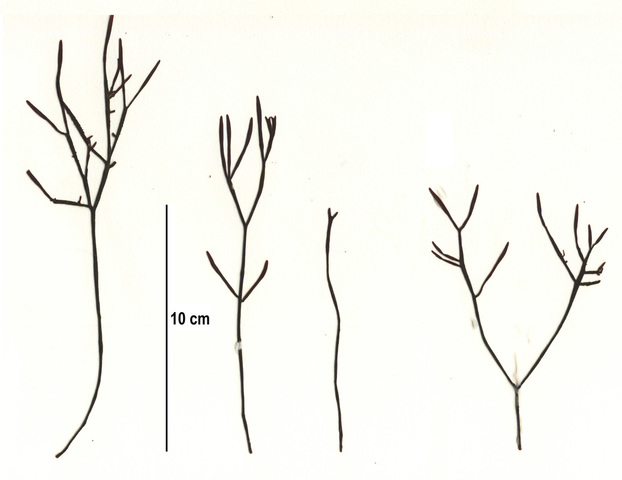Prionitis filiformis

Specimen collection number SCL 15346 in the UBC Herbarium Algae Database. Search the collection numbers in the database for more information on these specimens, or search the species for further occurrences. Images courtesy of Sandra Lindstrom.
This red alga is wiry, branched species that grows in various habitats. The above specimens were collected from 5th Beach on Calvert Island, and were found growing on bedrock in the low intertidal zone. Branches are cylindrical or slightly tapered at the ends, lack ridges and furrows, and are typically less than 5 cm wide.
Like other members of the Prionitis genus, this species releases a bleach-like smell when crushed that is thought to be associated with a chemical defense that protects the seaweed from grazers.
Like other members of the Prionitis genus, this species releases a bleach-like smell when crushed that is thought to be associated with a chemical defense that protects the seaweed from grazers.
References
Druehl, L. 2000. Pacific Seaweeds: A guide to common seaweeds of the west coast. Harbour Publishing: Madeira Park, BC, Canada. Pp.118-119.
Gabrielson, Paul W., Thomas Benjamin Widdowson, and Sandra C. Lindstrom. Keys to the seaweeds and seagrasses of southeast Alaska, British Columbia, Washington, and Oregon. No. 7. University of British Columbia, 2006.
Authors and editors of page
Beatrice Proudfoot and Kelly Fretwell (2016)
Druehl, L. 2000. Pacific Seaweeds: A guide to common seaweeds of the west coast. Harbour Publishing: Madeira Park, BC, Canada. Pp.118-119.
Gabrielson, Paul W., Thomas Benjamin Widdowson, and Sandra C. Lindstrom. Keys to the seaweeds and seagrasses of southeast Alaska, British Columbia, Washington, and Oregon. No. 7. University of British Columbia, 2006.
Authors and editors of page
Beatrice Proudfoot and Kelly Fretwell (2016)



